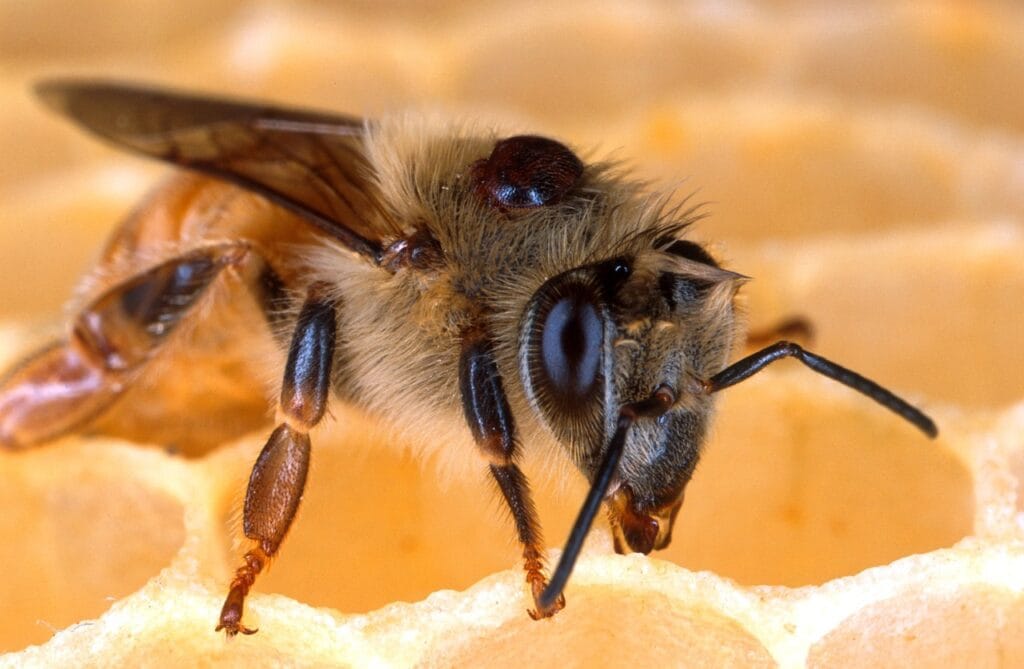A responsible beekeeper should understand several key areas to maintain the health and wellness of their honey bee colonies.
Healthy bees are fundamental for successful beekeeping and productive hives. Here are the main insights:
1. Primary Threats to Honey Bee Health
- Parasites and Pests: The Varroa mite is the most significant threat, transmitting viruses and weakening bee immunity. Other pests include tracheal mites, hive beetles, and wax moths.[1][2][3]
- Pathogens: Bees can suffer from bacterial, viral, fungal, and protozoan diseases. Notable diseases include American and European foulbrood (bacterial), Deformed Wing Virus (viral), and Chalkbrood or Stonebrood (fungal).[4][5][6]
- Poor Nutrition: Lack of diverse and abundant forage can lead to malnutrition, impeding brood development and weakening colonies.[7][8][1]
- Pesticide Exposure: Agrochemicals may be lethal or cause sublethal effects that affect bee behavior, immunity, and reproduction.[2][1]
2. Best Management Practices for Hive Health
- Regular Hive Inspections: Frequently check for signs of disease, pests, or stress. Early detection allows for prompt intervention.[9][10]
- Good Hive Location: Place hives in sunny, dry locations with good airflow to reduce pests and disease. Facing the entrance towards morning sun can encourage activity.[11]
- Cleanliness: Routinely clean hive equipment and tools to prevent disease spread. Avoid using old equipment from previously infected hives.[10][4]
- Nutrition Management: Ensure bees have constant access to water and a variety of flowering plants for pollen and nectar. Supplement with sugar syrup or pollen if forage is limited.[8][12][7]
- Swarm and Colony Management: Reduce overcrowding, prevent swarming, and manage colony growth by splitting or combining colonies when necessary.[7]
- Queen Health: Maintain young, good-quality queens for colony strength and vigor.[9][7]
- Disease and Pest Control: Use a combination of cultural, mechanical, and (when necessary) chemical methods to control pests and diseases such as Varroa mites and Nosema.[13][5][14]
3. Recognizing and Treating Common Problems
- Visual Symptoms: Look for chalky or mummified larvae (Chalkbrood), hairless or trembling adult bees (Viral infections), and irregular brood patterns.[15][6][4]
- Behavioral Signs: Unusual bee inactivity or aggression, decreased honey production, and weak colonies may indicate underlying health problems.[10][9]
- Testing: Use diagnostic methods for pests/diseases, such as sampling for Varroa mites and lab tests for specific pathogens.[5][3]
4. Supporting Bee Wellness
- Genetic Stock Improvements: Encourage hygienic traits through selective breeding and introducing queens from disease-resistant lineages.[16]
- Organic Practices: Where feasible, minimize the use of synthetic chemicals—research shows organic methods can rival conventional ones in sustaining bee health and productivity.[13]
Quick Reference Table: Common Honey Bee Health Issues
| Issue/Threat | Symptoms/Impact | Prevention/Treatment |
| Varroa mites | Weak, virus-prone bees | Regular mite checks & treatments[1][2][3] |
| Chalkbrood (Fungal) | “Chalky,” mummified larvae | Ventilation, hygiene, genetic stock[4][6] |
| Nosema (Protozoan) | Digestive issues, weak winter bees | Replace old comb, monitor & treat[5][3] |
| Poor Nutrition | Weak brood, slow colony growth | Supplement feeding, diverse forage[7][8][12] |
| Pesticide exposure | Neurological, reproductive effects | Hive placement, minimize exposure[1][13][2] |
By staying alert, inspecting regularly, and proactively applying best management practices, beekeepers can keep their honey bees healthier and more productive throughout the year.[8][9][10]
⁂
- https://www.ars.usda.gov/oc/br/ccd/index/
- https://cast-science.org/wp-content/uploads/2018/12/QTA20171_Bee_Health_565CB839D149E.pdf
- https://extension.psu.edu/a-quick-reference-guide-to-honey-bee-parasites-pests-predators-and-diseases/
- https://en.wikipedia.org/wiki/List_of_diseases_of_the_honey_bee
- https://www.ars.usda.gov/is/np/honeybeediseases/honeybeediseases.pdf
- https://bees.caes.uga.edu/beekeeping-resources/honey-bee-disorders.html
- http://extension.msstate.edu/publications/colony-growth-and-seasonal-management-honey-bees
- https://honeybeehealthcoalition.org/hive-management-additional-resources/
- https://honeybeehealthcoalition.org/wp-content/uploads/2019/01/HBHC_Hive_BMPs_v1.0_reduced.pdf
- https://miller-mfg.com/blogs/blog/7-tips-for-keeping-happy-and-healthy-bees
- https://scientificbeekeeping.com/the-rules-for-successful-beekeeping/
- https://agriculture.vic.gov.au/livestock-and-animals/honey-bees/health-and-welfare/feeding-honey-bees-to-prevent-starvation
- https://www.psu.edu/news/agricultural-sciences/story/organic-beekeeping-rivals-conventional-methods-bee-health-productivity
- https://honeybeehealthcoalition.org/resources/hive-health-best-management-practices/
- https://extension.okstate.edu/fact-sheets/honeybee-diseases-and-their-recognition-epp-7344.html
- https://www.pollinator.org/honeybee-health



